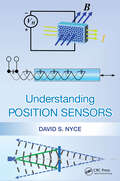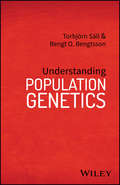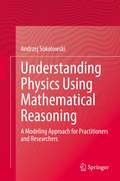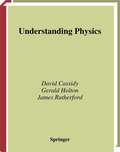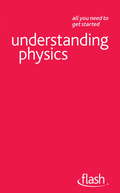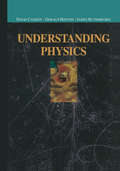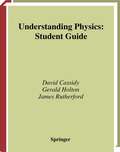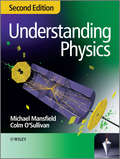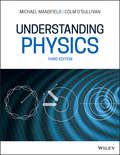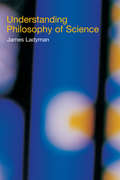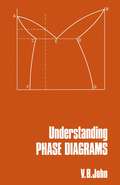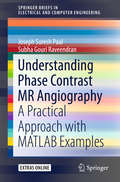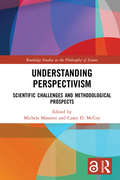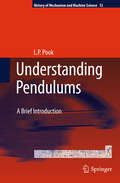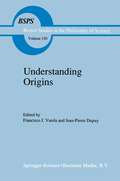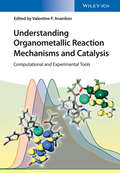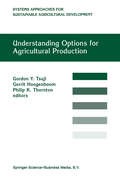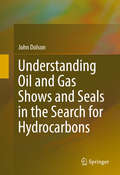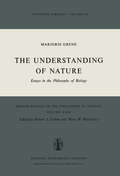- Table View
- List View
Understanding Position Sensors
by David NyceAs the definitive resource on position sensing technology, Understanding Position Sensors encompasses all aspects necessary for a full understanding of the field, with topics of background, operational theory, design, and application. While grasping the theory of technologies used in the measurement of linear and angular/rotary position sensors, the reader will also learn about terminology, interfacing, testing, and other valuable concepts that are useful in the understanding of sensors in general. The first three chapters provide readers with the necessary background information on sensors. These chapters review the working definitions and conventions used in sensing technology; specification of position sensors and the effect on performance; and sensor output types, plus an extensive section covering communication protocols. The remaining chapters describe each separate sensor technology in detail. These include resistive sensors, cable extension transducers, capacitive sensors, inductive sensors, LVDT and RVDT sensors, distributed impedance sensors, Hall effect sensors, magnetoresistive sensors, magnetostrictive sensors, linear and rotary encoders, optical triangulation position sensors, and ultrasonic position sensors. Presents sensor specification, theory of operation, sensor design, and application criteria Reviews the background history of position sensors as well as the underlying engineering techniques Includes end-of-chapter exercises Understanding Position Sensors is written for electrical, mechanical, and material engineers, as well as for engineering students who are interested in understanding sensor technologies, and can be used as a textbook for an engineering course on sensor technology.
Understanding Position Sensors
by David NyceAs the definitive resource on position sensing technology, Understanding Position Sensors encompasses all aspects necessary for a full understanding of the field, with topics of background, operational theory, design, and application. While grasping the theory of technologies used in the measurement of linear and angular/rotary position sensors, the reader will also learn about terminology, interfacing, testing, and other valuable concepts that are useful in the understanding of sensors in general. The first three chapters provide readers with the necessary background information on sensors. These chapters review the working definitions and conventions used in sensing technology; specification of position sensors and the effect on performance; and sensor output types, plus an extensive section covering communication protocols. The remaining chapters describe each separate sensor technology in detail. These include resistive sensors, cable extension transducers, capacitive sensors, inductive sensors, LVDT and RVDT sensors, distributed impedance sensors, Hall effect sensors, magnetoresistive sensors, magnetostrictive sensors, linear and rotary encoders, optical triangulation position sensors, and ultrasonic position sensors. Presents sensor specification, theory of operation, sensor design, and application criteria Reviews the background history of position sensors as well as the underlying engineering techniques Includes end-of-chapter exercises Understanding Position Sensors is written for electrical, mechanical, and material engineers, as well as for engineering students who are interested in understanding sensor technologies, and can be used as a textbook for an engineering course on sensor technology.
Understanding Population Genetics
by Torbjörn Säll Bengt O. BengtssonAn inspiring introduction to a vital scientific field. The reader is taken through ten mathematical derivations that lead to important results, explaining in a hands-on manner the key concepts and methods of theoretical population genetics. The derivations are carefully worked out and easy to follow. Particular attention is given to the underlying assumptions and the mathematics used. The results are discussed and broadened out with relevant current implications. All topics feature questions with helpful answers. The book is intended for the reader who already knows some population genetics but requires a more comprehensive understanding. It is particularly suited to those who analyse genetic data and wish to better grasp what their results actually mean. It will also be helpful for those who wish to understand how population genetics contributes to the explanation of evolution. Or as the writers claim: If one wants to understand life – in all its improbable and amazing richness – one must start by understanding population genetics.
Understanding Physics Using Mathematical Reasoning: A Modeling Approach for Practitioners and Researchers
by Andrzej SokolowskiThis book speaks about physics discoveries that intertwine mathematical reasoning, modeling, and scientific inquiry. It offers ways of bringing together the structural domain of mathematics and the content of physics in one coherent inquiry. Teaching and learning physics is challenging because students lack the skills to merge these learning paradigms. The purpose of this book is not only to improve access to the understanding of natural phenomena but also to inspire new ways of delivering and understanding the complex concepts of physics. To sustain physics education in college classrooms, authentic training that would help develop high school students’ skills of transcending function modeling techniques to reason scientifically is needed and this book aspires to offer such trainingThe book draws on current research in developing students’ mathematical reasoning. It identifies areas for advancements and proposes a conceptual framework that is tested in several case studies designed using that framework. Modeling Newton’s laws using limited case analysis, Modeling projectile motion using parametric equations and Enabling covariational reasoning in Einstein formula for the photoelectric effect represent some of these case studies. A wealth of conclusions that accompany these case studies, drawn from the realities of classroom teaching, is to help physics teachers and researchers adopt these ideas in practice.
Understanding Physics: Teacher Guide (Undergraduate Texts in Contemporary Physics)
by David Cassidy Gerald Holton F.James RutherfordUnderstanding Physics is a completely revised, updated, and expanded e- tion of the Project Physics Course. It is an integrated introductory physics course, developed with funding from the Carnegie Corporation and the Sloan Foundation and with the close cooperation of Springer-Verlag New York. In approach and content, Understanding Physics follows the trail blazed by the earlier versions, but it includes more recent developments in physics and a stronger emphasis on the relationships among physics, technology, and society. We have sought especially to incorporate the salient lessons of recent physics education research and practical experience gained in the classroom. The Audience Understanding Physics is written primarily for undergraduate college s- dents not intending (at least initially) to enter careers in science or en- neering. These may include liberal-arts students, business majors, prelegal, and prospective architecture students. We have found that when the course is taken with laboratory work, it has been deemed suitable by medical schools for premedical students.
Understanding Physics: Teach Yourself (Flash)
by Jim BreithauptThe books in this bite-sized new series contain no complicated techniques or tricky materials, making them ideal for the busy, the time-pressured or the merely curious. Understanding Physics is a short, simple and to-the-point guide. In just 96 pages, the reader will learn all the basics, from atoms and molecules to forces, energy and quantum theory. Ideal for the busy, the time-pressured or the merely curious, Understanding Physics is a quick, no-effort way to break into this fascinating topic.
Understanding Physics (Undergraduate Texts in Contemporary Physics)
by David C. Cassidy Gerald Holton F. James RutherfordA thorough grounding in contemporary physics while placing the subject into its social and historical context. Based largely on the highly respected Project Physics Course developed by two of the authors, it also integrates the results of recent pedagogical research. The text thus teaches the basic phenomena in the physical world and the concepts developed to explain them; shows that science is a rational human endeavour with a long and continuing tradition, involving many different cultures and people; develops facility in critical thinking, reasoned argumentation, evaluation of evidence, mathematical modelling, and ethical values. The treatment emphasises not only what we know but also how we know it, why we believe it, and what effects this knowledge has.
Understanding Physics: Student Guide (Undergraduate Texts in Contemporary Physics)
by David Cassidy Gerald Holton James RutherfordLaboratory Manual to accompany Understanding Physics.
Understanding Physics
by Michael Mansfield Colm O'SullivanUnderstanding Physics – Second edition is a comprehensive, yet compact, introductory physics textbook aimed at physics undergraduates and also at engineers and other scientists taking a general physics course. Written with today's students in mind, this text covers the core material required by an introductory course in a clear and refreshing way. A second colour is used throughout to enhance learning and understanding. Each topic is introduced from first principles so that the text is suitable for students without a prior background in physics. At the same time the book is designed to enable students to proceed easily to subsequent courses in physics and may be used to support such courses. Mathematical methods (in particular, calculus and vector analysis) are introduced within the text as the need arises and are presented in the context of the physical problems which they are used to analyse. Particular aims of the book are to demonstrate to students that the easiest, most concise and least ambiguous way to express and describe phenomena in physics is by using the language of mathematics and that, at this level, the total amount of mathematics required is neither large nor particularly demanding. 'Modern physics' topics (relativity and quantum mechanics) are introduced at an earlier stage than is usually found in introductory textbooks and are integrated with the more 'classical' material from which they have evolved. This book encourages students to develop an intuition for relativistic and quantum concepts at as early a stage as is practicable. The text takes a reflective approach towards the scientific method at all stages and, in keeping with the title of the text, emphasis is placed on understanding of, and insight into, the material presented.
Understanding Physics
by Michael Mansfield Colm O'SullivanUnderstanding Physics – Second edition is a comprehensive, yet compact, introductory physics textbook aimed at physics undergraduates and also at engineers and other scientists taking a general physics course. Written with today's students in mind, this text covers the core material required by an introductory course in a clear and refreshing way. A second colour is used throughout to enhance learning and understanding. Each topic is introduced from first principles so that the text is suitable for students without a prior background in physics. At the same time the book is designed to enable students to proceed easily to subsequent courses in physics and may be used to support such courses. Mathematical methods (in particular, calculus and vector analysis) are introduced within the text as the need arises and are presented in the context of the physical problems which they are used to analyse. Particular aims of the book are to demonstrate to students that the easiest, most concise and least ambiguous way to express and describe phenomena in physics is by using the language of mathematics and that, at this level, the total amount of mathematics required is neither large nor particularly demanding. 'Modern physics' topics (relativity and quantum mechanics) are introduced at an earlier stage than is usually found in introductory textbooks and are integrated with the more 'classical' material from which they have evolved. This book encourages students to develop an intuition for relativistic and quantum concepts at as early a stage as is practicable. The text takes a reflective approach towards the scientific method at all stages and, in keeping with the title of the text, emphasis is placed on understanding of, and insight into, the material presented.
Understanding Physics
by Colm O'Sullivan Michael M. MansfieldAn updated and thoroughly revised third edition of the foundational text offering an introduction to physics with a comprehensive interactive website The revised and updated third edition of Understanding Physics presents a comprehensive introduction to college-level physics. Written with today's students in mind, this compact text covers the core material required within an introductory course in a clear and engaging way. The authors – noted experts on the topic – offer an understanding of the physical universe and present the mathematical tools used in physics. The book covers all the material required in an introductory physics course. Each topic is introduced from first principles so that the text is suitable for students without a prior background in physics. At the same time the book is designed to enable students to proceed easily to subsequent courses in physics and may be used to support such courses. Relativity and quantum mechanics are introduced at an earlier stage than is usually found in introductory textbooks and are integrated with the more 'classical' material from which they have evolved. Worked examples and links to problems, designed to be both illustrative and challenging, are included throughout. The links to over 600 problems and their solutions, as well as links to more advanced sections, interactive problems, simulations and videos may be made by typing in the URL’s which are noted throughout the text or by scanning the micro QR codes given alongside the URL’s, see: http://up.ucc.ieThis new edition of this essential text: Offers an introduction to the principles for each topic presented Presents a comprehensive yet concise introduction to physics covering a wide range of material Features a revised treatment of electromagnetism, specifically the more detailed treatment of electric and magnetic materials Puts emphasis on the relationship between microscopic and macroscopic perspectives Is structured as a foundation course for undergraduate students in physics, materials science and engineering Has been rewritten to conform with the revised definitions of SI base units which came into force in May 2019 Written for first year physics students, the revised and updated third edition of Understanding Physics offers a foundation text and interactive website for undergraduate students in physics, materials science and engineering.
Understanding Physics
by Colm O'Sullivan Michael M. MansfieldAn updated and thoroughly revised third edition of the foundational text offering an introduction to physics with a comprehensive interactive website The revised and updated third edition of Understanding Physics presents a comprehensive introduction to college-level physics. Written with today's students in mind, this compact text covers the core material required within an introductory course in a clear and engaging way. The authors – noted experts on the topic – offer an understanding of the physical universe and present the mathematical tools used in physics. The book covers all the material required in an introductory physics course. Each topic is introduced from first principles so that the text is suitable for students without a prior background in physics. At the same time the book is designed to enable students to proceed easily to subsequent courses in physics and may be used to support such courses. Relativity and quantum mechanics are introduced at an earlier stage than is usually found in introductory textbooks and are integrated with the more 'classical' material from which they have evolved. Worked examples and links to problems, designed to be both illustrative and challenging, are included throughout. The links to over 600 problems and their solutions, as well as links to more advanced sections, interactive problems, simulations and videos may be made by typing in the URL’s which are noted throughout the text or by scanning the micro QR codes given alongside the URL’s, see: http://up.ucc.ieThis new edition of this essential text: Offers an introduction to the principles for each topic presented Presents a comprehensive yet concise introduction to physics covering a wide range of material Features a revised treatment of electromagnetism, specifically the more detailed treatment of electric and magnetic materials Puts emphasis on the relationship between microscopic and macroscopic perspectives Is structured as a foundation course for undergraduate students in physics, materials science and engineering Has been rewritten to conform with the revised definitions of SI base units which came into force in May 2019 Written for first year physics students, the revised and updated third edition of Understanding Physics offers a foundation text and interactive website for undergraduate students in physics, materials science and engineering.
Understanding Philosophy of Science
by James LadymanFew can imagine a world without telephones or televisions; many depend on computers and the Internet as part of daily life. Without scientific theory, these developments would not have been possible.In this exceptionally clear and engaging introduction to philosophy of science, James Ladyman explores the philosophical questions that arise when we reflect on the nature of the scientific method and the knowledge it produces. He discusses whether fundamental philosophical questions about knowledge and reality might be answered by science, and considers in detail the debate between realists and antirealists about the extent of scientific knowledge. Along the way, central topics in philosophy of science, such as the demarcation of science from non-science, induction, confirmation and falsification, the relationship between theory and observation and relativism are all addressed. Important and complex current debates over underdetermination, inference to the best explaination and the implications of radical theory change are clarified and clearly explained for those new to the subject.
Understanding Philosophy of Science
by James LadymanFew can imagine a world without telephones or televisions; many depend on computers and the Internet as part of daily life. Without scientific theory, these developments would not have been possible.In this exceptionally clear and engaging introduction to philosophy of science, James Ladyman explores the philosophical questions that arise when we reflect on the nature of the scientific method and the knowledge it produces. He discusses whether fundamental philosophical questions about knowledge and reality might be answered by science, and considers in detail the debate between realists and antirealists about the extent of scientific knowledge. Along the way, central topics in philosophy of science, such as the demarcation of science from non-science, induction, confirmation and falsification, the relationship between theory and observation and relativism are all addressed. Important and complex current debates over underdetermination, inference to the best explaination and the implications of radical theory change are clarified and clearly explained for those new to the subject.
Understanding Phase Contrast MR Angiography: A Practical Approach with MATLAB examples (SpringerBriefs in Electrical and Computer Engineering)
by Joseph Suresh Paul Subha GRProviding many unique MATLAB codes and functions throughout, this book covers the basics of Magnetic Resonance Imaging (MRI), leading to an in-depth understanding of the concepts and tools required for analysis and interpretation of Phase Contrast MR Angiography (PC-MRA). The concept of PC-MRA is often difficult, but essential for practicing engineers and scientists working in MR related areas. The concepts are better understood by uniquely combining the physical principles of fluid flow and MR imaging, laid out by modeling the theory and applications using a commonly used software tool MATLAB®. The book starts with a detailed theory of PC-MRA followed by a description of various image processing methods, including detailed MATLAB codes used for their implementation. The flow concepts in the context of MR imaging are explained using MATLAB based simulations.
Understanding Perspectivism: Scientific Challenges and Methodological Prospects (Routledge Studies in the Philosophy of Science)
by Michela Massimi Casey D. McCoyThis edited collection is the first of its kind to explore the view called perspectivism in philosophy of science. The book brings together an array of essays that reflect on the methodological promises and scientific challenges of perspectivism in a variety of fields such as physics, biology, cognitive neuroscience, and cancer research, just as a few examples. What are the advantages of using a plurality of perspectives in a given scientific field and for interdisciplinary research? Can different perspectives be integrated? What is the relation between perspectivism, pluralism, and pragmatism? These ten new essays by top scholars in the field offer a polyphonic journey towards understanding the view called ‘perspectivism’ and its relevance to science.
Understanding Perspectivism: Scientific Challenges and Methodological Prospects (Routledge Studies in the Philosophy of Science)
by Michela Massimi Casey D. McCoyThis edited collection is the first of its kind to explore the view called perspectivism in philosophy of science. The book brings together an array of essays that reflect on the methodological promises and scientific challenges of perspectivism in a variety of fields such as physics, biology, cognitive neuroscience, and cancer research, just as a few examples. What are the advantages of using a plurality of perspectives in a given scientific field and for interdisciplinary research? Can different perspectives be integrated? What is the relation between perspectivism, pluralism, and pragmatism? These ten new essays by top scholars in the field offer a polyphonic journey towards understanding the view called ‘perspectivism’ and its relevance to science.
Understanding Pendulums: A Brief Introduction (History of Mechanism and Machine Science #12)
by L.P. PookDespite their apparent simplicity, the behaviour of pendulums can be remarkably complicated. Historically, pendulums for specific purposes have been developed using a combination of simplified theory and trial and error. There do not appear to be any introductory books on pendulums, written at an intermediate level, and covering a wide range of topics. This book aims to fill the gap. It is written for readers with some background in elementary geometry, algebra, trigonometry and calculus. Historical information, where available and useful for the understanding of various types of pendulum and their applications, is included. Perhaps the best known use of pendulums is as the basis of clocks in which a pendulum controls the rate at which the clock runs. Interest in theoretical and practical aspects of pendulums, as applied to clocks, goes back more than four centuries. The concept of simple pendulums, which are idealised versions of real pendulums is introduced. The application of pendulums to clocks is described, with detailed discussion of the effect of inevitable differences between real pendulums and simple pendulums. In a clock, the objective is to ensure that the pendulum controls the timekeeping. However, pendulums are sometimes driven, and how this affects their behaviour is described. Pendulums are sometimes used for occult purposes. It is possible to explain some apparently occult results by using modern pendulum theory. For example, why a ring suspended inside a wine glass, by a thread from a finger, eventually strikes the glass. Pendulums have a wide range of uses in scientific instruments, engineering, and entertainment. Some examples are given as case studies. Indexed in the Book Citation Index– Science (BKCI-S)
Understanding Origins: Contemporary Views on the Origins of Life, Mind and Society (Boston Studies in the Philosophy and History of Science #130)
by Francisco J. Varela J. P. DupuyThe main intention of this book is to bring together contributions from biology, cognitive science, and the humanities for a joint exploration of some of the main contemporary notions dealing with the understanding of origins in life,mind and society. The question of origin is inseparable from a web of hypotheses that both shape and explain us. Although origin invites examination, it always seems to elude our grasp. Notions have always been produced to interpret the genesis of life, mind, and the social order, and these notions have all remained unstable in the face of theoretical and empirical challenges. In any given period, the central ideas on origin have had a mutual resonance frequently overlooked by specialists engaged in theirown particular fields. As a consequence, this book should be of interest to a wide audi ence. In particular, for all those engaged in the social sciences and the philosophy of science, it is unique document, since bridges to the natural sciences in a mutually illuminating way are hard to find. Whether as a primary source or as inspirational reading, we feel this book has a place in every library. The material comes from an international meeting held in September 13-16, 1987 at Stanford University, organized by F. Varela and J.-P. Dupuy at the request of the Program of Interdisciplinary Research of Stanford University. We are grateful to Rene Girard, the Program Director, for making it possible with the help of the Mellon Foundation.
Understanding Organometallic Reaction Mechanisms and Catalysis: Computational and Experimental Tools
by Valentin P. AnanikovExploring and highlighting the new horizons in the studies of reaction mechanisms that open joint application of experimental studies and theoretical calculations is the goal of this book. The latest insights and developments in the mechanistic studies of organometallic reactions and catalytic processes are presented and reviewed. The book adopts a unique approach, exemplifying how to use experiments, spectroscopy measurements, and computational methods to reveal reaction pathways and molecular structures of catalysts, rather than concentrating solely on one discipline. The result is a deeper understanding of the underlying reaction mechanism and correlation between molecular structure and reactivity. The contributions represent a wealth of first-hand information from renowned experts working in these disciplines, covering such topics as activation of small molecules, C-C and C-Heteroatom bonds formation, cross-coupling reactions, carbon dioxide converison, homogeneous and heterogeneous transition metal catalysis and metal-graphene systems. With the knowledge gained, the reader will be able to improve existing reaction protocols and rationally design more efficient catalysts or selective reactions. An indispensable source of information for synthetic, analytical, and theoretical chemists in academia and industry.
Understanding Organometallic Reaction Mechanisms and Catalysis: Computational and Experimental Tools
by Valentin P. AnanikovExploring and highlighting the new horizons in the studies of reaction mechanisms that open joint application of experimental studies and theoretical calculations is the goal of this book. The latest insights and developments in the mechanistic studies of organometallic reactions and catalytic processes are presented and reviewed. The book adopts a unique approach, exemplifying how to use experiments, spectroscopy measurements, and computational methods to reveal reaction pathways and molecular structures of catalysts, rather than concentrating solely on one discipline. The result is a deeper understanding of the underlying reaction mechanism and correlation between molecular structure and reactivity. The contributions represent a wealth of first-hand information from renowned experts working in these disciplines, covering such topics as activation of small molecules, C-C and C-Heteroatom bonds formation, cross-coupling reactions, carbon dioxide converison, homogeneous and heterogeneous transition metal catalysis and metal-graphene systems. With the knowledge gained, the reader will be able to improve existing reaction protocols and rationally design more efficient catalysts or selective reactions. An indispensable source of information for synthetic, analytical, and theoretical chemists in academia and industry.
Understanding Options for Agricultural Production (System Approaches for Sustainable Agricultural Development #7)
by G. Y. Tsuji G. Hoogenboom P. K. ThorntonThe first premise of this book is that farmers need access to options for improving their situation. In agricultural terms, these options might be manage ment alternatives or different crops to grow, that can stabilize or increase household income, that reduce soil degradation and dependence on off-farm inputs, or that exploit local market opportunities. Farmers need a facilitating environment, in which affordable credit is available if needed, in which policies are conducive to judicious management of natural resources, and in which costs and prices of production are stable. Another key ingredient of this facilitating environment is information: an understanding of which options are viable, how these operate at the farm level, and what their impact may be on the things that farmers perceive as being important. The second premise is that systems analysis and simulation have an impor tant role to play in fostering this understanding of options, traditional field experimentation being time-consuming and costly. This book summarizes the activities of the International Benchmark Sites Network for Agrotechnology Transfer (IBSNAT) project, an international initiative funded by the United States Agency for International Development (USAID). IBSNAT was an attempt to demonstrate the effectiveness of understanding options through systems analysis and simulation for the ultimate benefit of farm households in the tropics and subtropics. The idea for the book was first suggested at one of the last IBSNAT group meetings held at the University of Hawaii in 1993.
Understanding Oil and Gas Shows and Seals in the Search for Hydrocarbons
by John DolsonThis book explains in detail how to use oil and gas show information to find hydrocarbons. It covers the basics of exploration methodologies, drilling and mud systems, cuttings and mud gas show evaluation, fundamental log analysis, the pitfalls of log-calculated water saturations, and a complete overview of the use of pressures to understand traps and migration, hydrodynamics, and seal and reservoir quantification using capillary pressure. Also included are techniques for quickly generating pseudo-capillary pressure curves from simple porosity/permeability data, with examples of how to build spreadsheets in Excel, and a complete treatment of fluid inclusion analysis and fluid inclusion stratigraphy to map migration pathways. In addition, petroleum systems modeling and fundamental source rock geochemistry are discussed in depth, particularly in the context of unconventional source rock evaluation and screening tools for entering new plays. The book is heavily illustrated with numerous examples and case histories from the author’s 37 years of exploration experience. The topics covered in this book will give any young geoscientist a quick start on a successful career and serve as a refresher for the more experienced explorer.
The Understanding of Nature: Essays in the Philosophy of Biology (Boston Studies in the Philosophy and History of Science #23)
by Marjorie GreneNo student or colleague of Marjorie Grene will miss her incisive presence in these papers on the study and nature of living nature, and we believe the new reader will quickly join the stimulating discussion and critique which Professor Grene steadily provokes. For years she has worked with equally sure knowledge in the classical domain of philosophy and in modern epistemological inquiry, equally philosopher of science and metaphysician. Moreover, she has the deeply sensible notion that she should be a critically intelligent learner as much as an imaginatively original thinker, and as a result she has brought insightful expository readings of other philosophers and scientists to her own work. We were most fortunate that Marjorie Grene was willing to spend a full semester of a recent leave here in Boston, and we have on other occasions sought her participation in our colloquia and elsewhere. Now we have the pleasure of including among the Boston Studies in the Philosophy of Science this generous selection from Grene's philosophical inquiries into the understanding of the natural world, and of the men and women in it. Boston University Center for the R. S. COHEN Philosophy and History of Science M. W. W ARTOFSKY April 1974 PREFACE This collection spans - spottily - years from 1946 ('On Some Distinctions between Men and Brutes') to 1974 ('On the Nature of Natural Necessity').
